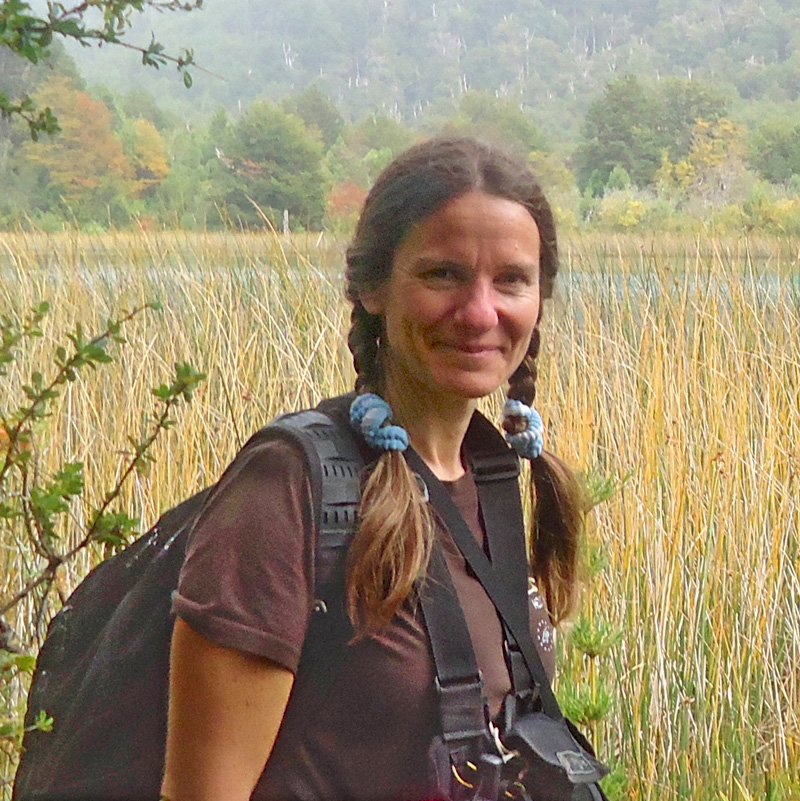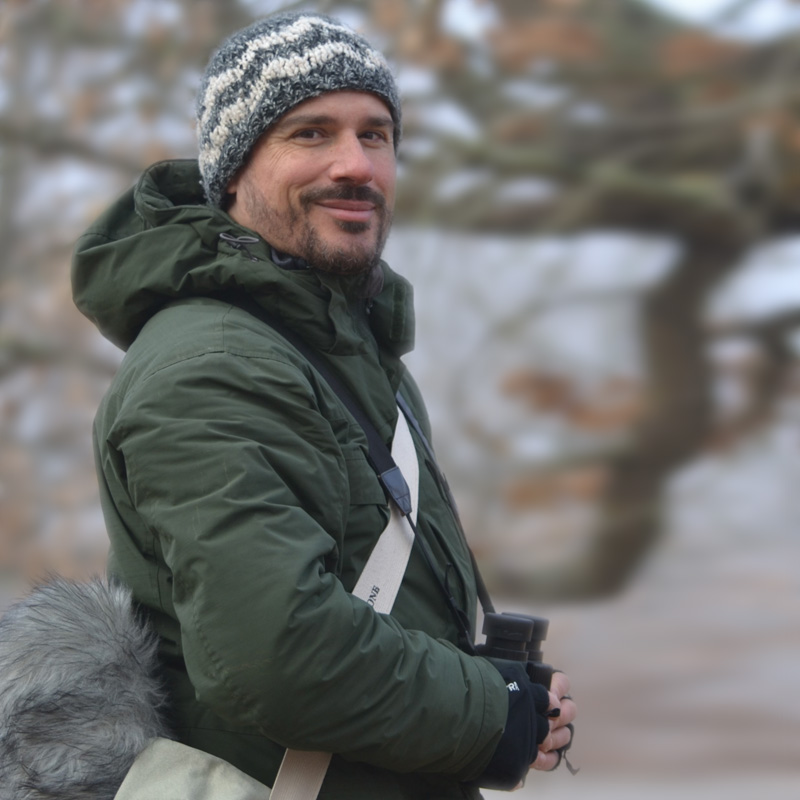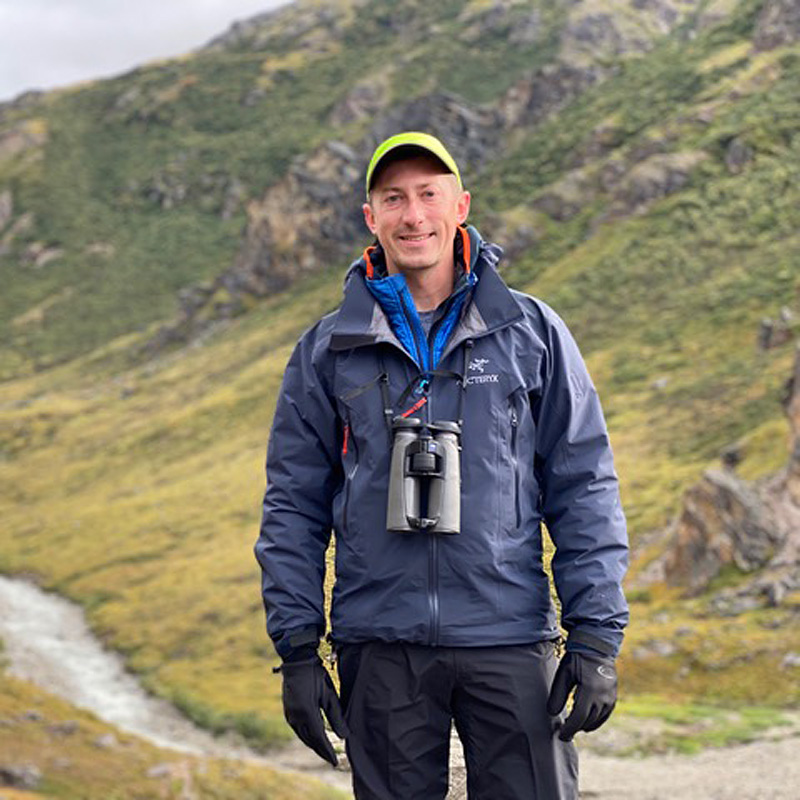Valeria Ojeda
Ecology Department, Universidad Nacional del Comahue (CRUB-UNC) and INIBIOMA-CONICET, 8400 Bariloche, Argentina

Topic:
Insights into Campephilus demography: a 25-year data set of nesting and mark-resight data for Magellanic Woodpeckers
A picture from 1974 shows an urban-born 2 years old Valeria handling pieces of snow at an Andean ski location; she cried from the cold as she was hypnotized by this newly discovered white element. The image reveals a habit that she never abandoned: explore, no matter the cost. A fortuitous family decision paved the way; at the age of 12, she settled in Bariloche, where she lived a sylvan and adventurous adolescence. Valeria became a young biologist and mother at the same time in 1997, and concluded a PhD program in 2006. She has a research position at CONICET (Argentine Scientific Agency) since 2008, with full-time dedication to avian studies and, more broadly, wildlife/wild land management and conservation practice. She has conducted several studies on forest raptors and woodpeckers, especially focusing on the Magellanic woodpecker (Campephilus magellanicus), her lifelong focal organism. Since 1998, Valeria has been banding nestling Magellanic Woodpeckers from a population in a protected temperate old-growth forest of 2000 ha (with 8-12 family groups, depending on the year), and from other populations around Bariloche city, both within and outside protected areas. She monitors adult and young survival, fecundity, mating behaviour and philopatry, aiming to determine the rates (and causes) of adult replacement and the causes of juvenile mortality.
Hugo Robles
Lecturer, Department of Biology of Organisms and Systems, University of Oviedo, Spain

Topic:
Living in a changing world: lessons from a long-term study of the Middle Spotted Woodpecker in fragmented landscapes
Hugo Robles studies forest birds as model organisms to address fundamental ecological questions with conservation implications. In collaboration with several colleagues, he strives to understand how populations and communities are structured in the face of current environmental challenges: land use intensification, habitat fragmentation, and climate change. A large part of his research is grounded in a long-term study (2000-) of the Middle Spotted Woodpecker (Dendrocoptes medius) in fragmented landscapes from the southern Cantabrian mountains (NW Spain). He opened this research line as a doctorate student at the University of León. Since then, his team has been able to monitor all local populations in the entire study area annually, which constitutes an excellent dataset to understand the factors underlying the survival of (meta)populations. Using multiple techniques, from bird tagging to bioacoustics and genetics, they strive to investigate the individual variation in behaviours behind crucial processes for population persistence, such as dispersal or reproduction. The ultimate goal is to understand the link between individual variation and population processes to properly design effective conservation actions. Recently, he participates in a project that aims to understand how multiple interactions among biotic (fungi, insects, birds) and abiotic factors determine the creation of tree cavities in the face of global environmental changes (anthropogenic forest use, climate change).
Morgan Tingley
Associate Professor of Ecology and Evolutionary Biology, University of California, Los Angeles, USA

Topic:
After the Fire: Woodpeckers and diversity dynamics in a flammable world
Morgan Tingley originally hails from the region of New England, U.S.A., and has been studying the impacts of human-driven environmental change on bird communities since he was an undergrad at Harvard University. In 2020, Morgan Tingley joined the faculty at the University of California, Los Angeles, after previously serving as an Assistant Professor at the University of Connecticut and as a David H. Smith Conservation Research Fellow at Princeton University. He holds a Ph.D. in Environmental Science, Policy, and Management from the University of California, Berkeley and an M.Sc. from Oxford University. He is a recipient of the “Wings across the Americas” conservation award from the U.S. Forest Service for his work on Black-backed Woodpeckers (Picoides arcticus) in post-fire forests of California, as well as the James G. Cooper Young Professional Award from the American Ornithological Society. In his plenary talk, he will draw from insights from radio-tracking, occupancy modelling and DNA barcoding of prey items to analyse the dynamics of Black-backed Woodpecker populations in coniferous forests impacted by fire. His nearly 100 research papers have been covered widely by the popular press, including features by The New York Times, The LA Times, Mongabay, and Washington Post.
Kerri Vierling
Professor of Wildlife Sciences, University of Idaho, Moscow, Idaho, USA

Topic:
Taking the (laser) pulse of Picidae: woodpeckers, lidar, and biodiversity planning
Kerri Vierling is a professor of wildlife sciences at the University of Idaho, where she teaches a variety of courses in ecology, ornithology, and climate change effects on wildlife. She grew up in the Seattle area, where she enjoyed playing music and soccer. She earned her BA in biology at Colorado College and received her MS and PhD at the University of Colorado. Kerri Vierling studies how forest characteristics and management influence animal distributions, with a focus on woodpecker ecology. Much of her pioneering work using lidar to better understand animal ecology and distributions has focused upon woodpeckers, and her research spans multiple spatial scales, from the tree cavity up to regional landscapes. As an early career scientist, she received the prestigious CAREER award from the National Science Foundation to study relationships among post-fire environments, woodpecker habitat selection, and cavity nest webs. She currently leads a NASA-funded effort to examine how space-based lidar data from the Global Ecosystem Dynamics Investigation (GEDI) instrument can be used to better understand wildlife-habitat relationships across multiple western states in the USA, with an emphasis on woodpeckers and the diversity supported by the woodpecker guild.